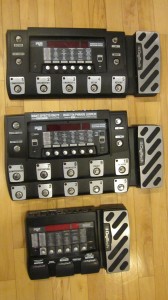
First Round of Edits Done on the RP500 Update: Some Impressions
I’ve completed my initial revisions to the RP500 v16 Huntersounds patch set, meaning that I’ve updated all 50 patches in the revised (v17) set with new settings for amp EQ, and other adjustments in many cases. There’s more work to be done to get it ready for release within the next week or so, and in the meantime, here’s what I’ve learned so far.

In general, the RP500 is a very rewarding device to work with. The thing sounds great, and the ability to put it into pedalboard mode, where you have separate footswitches for compression, distortion, FX, delay, and reverb on/off is hugely powerful for live performance. On many of my v17 Huntersounds patches for the 500, stepping on the compressor footswitch alone immediately makes the tone louder and more intense–just the thing for opening up some room for the harp solo. The RP500’s implicit grouping of patches in blocks of 5–you have to hit two footswitches in sequence to get to the next patch if it happens to be in a different block of 5 patches–is both a benefit and a hindrance: you can’t just hold a footswitch down and scroll through everything, the way you can with the 155/255/355, which is a drag, but in preset mode you can easily jump around in any order you like between the 5 patches in a block. What that means is that it’s even more important to set your patches up on a per-song basis for rapid switching when you need it. Specifically, you want your patches for a particular song residing together in a 5-patch block.
I’ve never had to use more than 5 patches in a song, and I’m used to setting my patches up in the order I need for rapid switching, so that limitation isn’t a problem for me. Most people don’t do a lot of switching anyway, and so it’s even less of problem for most other players.
Anyway, I like this box. Stay tuned for the Huntersounds v17 patchset for RP500 release announcement soon.
Related Posts
Leave a Reply
You must be logged in to post a comment.
WHAT’S NEW
Categories
- Audio/Video
- Blog
- Blue Future
- Digitech RP Tricks and Tips
- Discography, CDs, Projects, Info, Notes
- Featured Video
- For the Beginner
- Gallery
- Hunter's Effects
- Hunter's Music
- Huntersounds for Fender Mustang
- Meet the Pros
- More Video
- MPH: Maw/Preston/Hunter
- My Three Big Contributions
- Player's Resources
- Pro Tips & Techniques
- Recommended Artists & Recordings
- Recommended Gear
- Recorded Performances
- Reviews, Interviews, Testimonials
- The Lucky One
- Uncategorized
- Upcoming Performances
- Zoom G3 Tips and Tricks